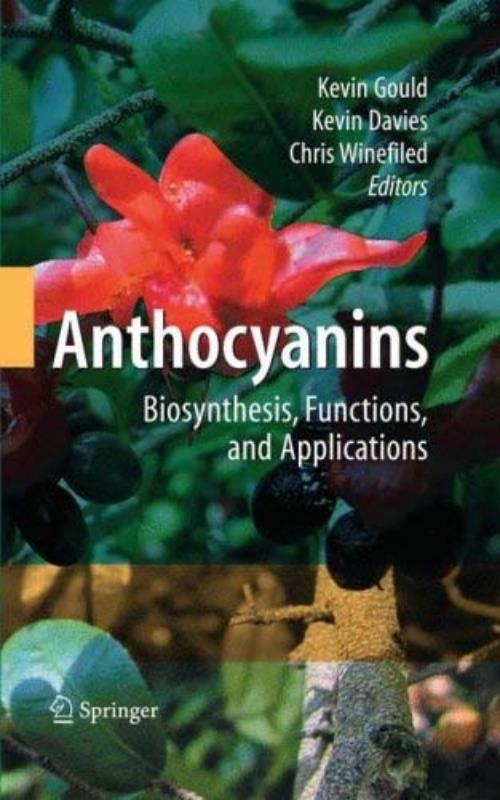
Kevin Gould Kevin Davies Chris Winefiled Editors Anthocyanins Biosynthesis,Functions, and Applications ②Springer
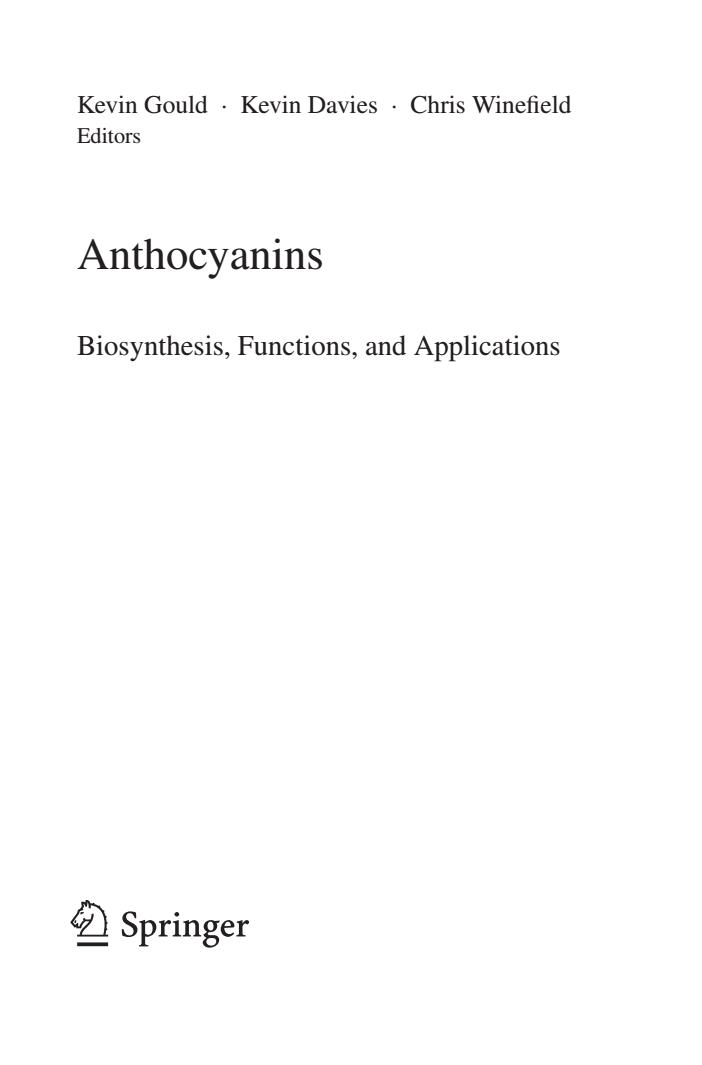
Kevin Gould·Kevin Davies·Chris Winefield Editors Anthocyanins Biosynthesis,Functions,and Applications ②Springer
Kevin Gould · Kevin Davies · Chris Winefield Editors Anthocyanins Biosynthesis, Functions, and Applications 123
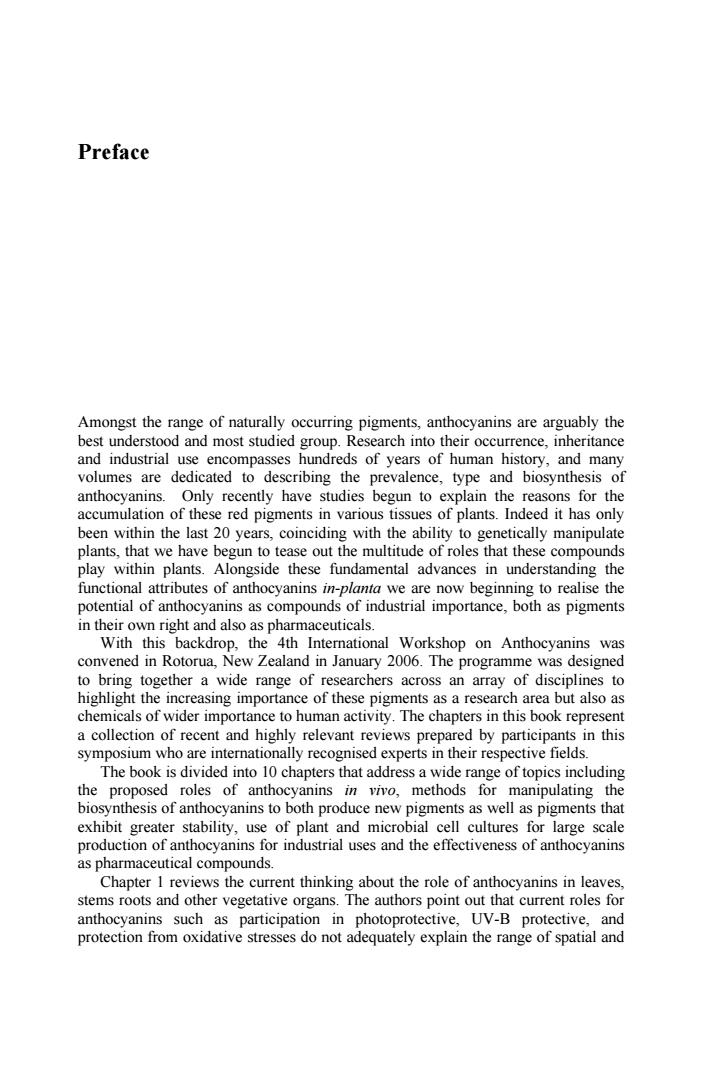
Preface at the range of natrly occurring Pigments anihoeyanins sare arguably the nd mo st stu ed grou into the edicated ribin stu of variou r pla L e last 20 y play in fun I advan f attributes of anthocyanins n-planta we are now beginn g to realise the potential I of anthocyanins as compounds of industrial importance,both as pigments in their own right and also as pharmaceuticals. With this backdrop,the 4th International Workshop on Anthocyanins was convened in Rotorua,New Zealand in January 2006.The programme was designed to bring together a wide range of researchers across an array of disciplines to highlight the increasing importance of these pigments as a research area but also as chemicals of wider importance to human activity.The chapters in this book represent a collection of recent and highly relevant reviews prepared by participants in this symposium who are internationally recognised experts in their respective fields The book is divided into 10 chapters that address a wide range of topics including the proposed roles of anthocyanins in vivo,methods for manipulating the biosynthesis of anthocyanins to both produce new pigments as well as pigments that exhibit greater stability,use of plant and microbial cell cultures for large scale production of anthocyanins for industrial uses and the effectiveness of anthocyanins as pharmaceutical compounds. Chapter I reviews the current thinking about the role of anthocyanins in leaves stems roots and other vegetative organs.The authors point out that current roles for anthocyanins such as participation in photoprotective.UV-B protective.and protection from oxidative stresses do not adequately explain the range of spatial and
Preface Amongst the range of naturally occurring pigments, anthocyanins are arguably the best understood and most studied group. Research into their occurrence, inheritance and industrial use encompasses hundreds of years of human history, and many volumes are dedicated to describing the prevalence, type and biosynthesis of anthocyanins. Only recently have studies begun to explain the reasons for the accumulation of these red pigments in various tissues of plants. Indeed it has only been within the last 20 years, coinciding with the ability to genetically manipulate plants, that we have begun to tease out the multitude of roles that these compounds play within plants. Alongside these fundamental advances in understanding the functional attributes of anthocyanins in-planta we are now beginning to realise the potential of anthocyanins as compounds of industrial importance, both as pigments in their own right and also as pharmaceuticals. With this backdrop, the 4th International Workshop on Anthocyanins was convened in Rotorua, New Zealand in January 2006. The programme was designed to bring together a wide range of researchers across an array of disciplines to highlight the increasing importance of these pigments as a research area but also as chemicals of wider importance to human activity. The chapters in this book represent a collection of recent and highly relevant reviews prepared by participants in this symposium who are internationally recognised experts in their respective fields. The book is divided into 10 chapters that address a wide range of topics including the proposed roles of anthocyanins in vivo, methods for manipulating the biosynthesis of anthocyanins to both produce new pigments as well as pigments that exhibit greater stability, use of plant and microbial cell cultures for large scale production of anthocyanins for industrial uses and the effectiveness of anthocyanins as pharmaceutical compounds. Chapter 1 reviews the current thinking about the role of anthocyanins in leaves, stems roots and other vegetative organs. The authors point out that current roles for anthocyanins such as participation in photoprotective, UV-B protective, and protection from oxidative stresses do not adequately explain the range of spatial and
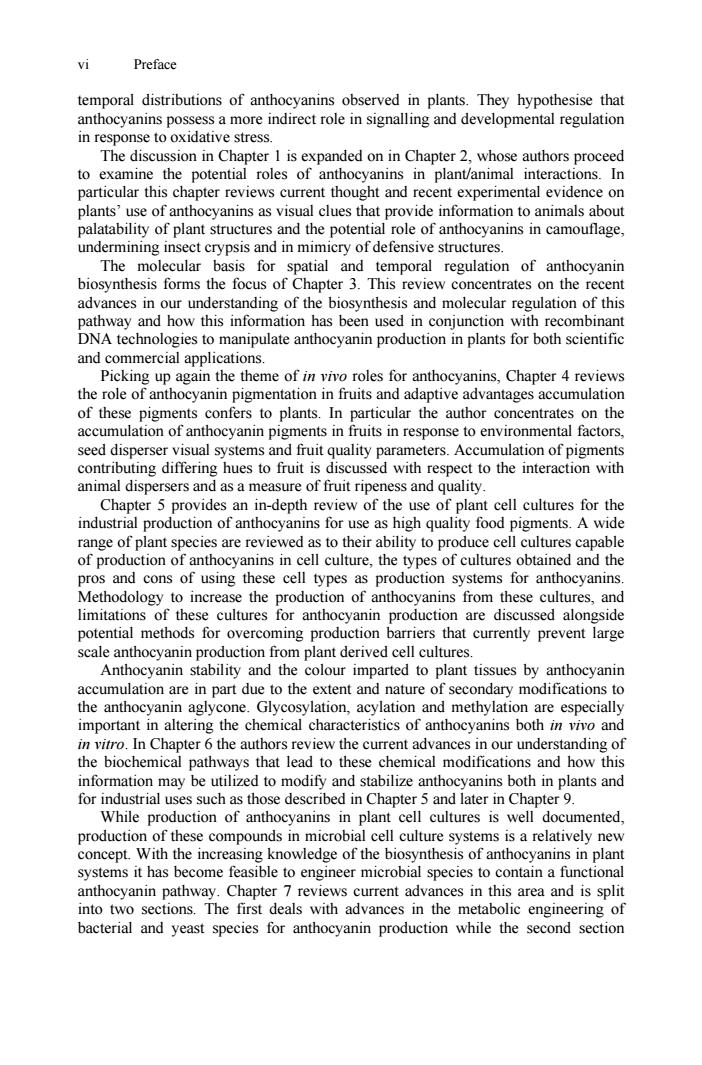
vi Preface temporal distributions of anthocyanins observed in plants.They hypothesise tha anthocyanins pos s a more indirect role in signalling and developmental regulation in response to oxidative stress The discussion in Chapter I is expanded on in Chapter 2,whose authors proceed to examine the potential roles of anthocyanins in plant/animal interactions.In particular this chapter reviews current thought and recent experimental evidence on plants use of anthocyanins as visual clues that provide information to animals about palatability of plant structures and the potential role of anthocyanins in camouflage, undermining insect crypsis and in mimicry of defensive structures. The molecular basis for spatial and temporal regulation of anthocyanin biosynthesis forms the focus of Chapter 3.This review concentrates on the recent advances in our understanding of the biosynthesis and molecular regulation of this pathway and how this information has been used in conjunction with recombinant DNA technologies to manipulate anthocvanin production in plants for both scientific and commercial applications. Picking up again the theme of in vivo roles for anthocyanins,Chapter 4 reviews the role of anthocyanin pigmentation in fruits and adaptive advantages accumulation of these pigments confers to plants.In particular the author concentrates on the accumulation of anthocyanin pigments in fruits in response to environmental factors, seed disperser visual systems and fruit quality parameters.Accumulation of pigments contributing differing hues to fruit is discussed with respect to the interaction with animal dispersers and as a measure of fruit ripeness and quality Chapter 5 provides an in-depth review of the use of plant cell cultures for the range of plant species are reviewed as to their ability to cultures capable of production of anthocvanins in cell culture.the typ s obtained and the pros and cons of using these cell types as produd ion systems for anthocvanins Methodology to inc rease the production anthocvanins from these and limitations of these cultures for antho anin production are discussed potential methods for overcoming production barriers that currently prevent large scale anthoc oduction from m plant der ived cell cult Anthoc stability and the mp cd to tissues by are due to y mo ficatio ethyla espe che th the ter pter emic that d ew an n m nts and While des p of yan ture a relat With the inc ge of t nthes feasible to engineer of anth systems it has r mi ontain a anthocyanin pathway.Chapter rev ws current adva ces in this area and is spl into two sections.The first deals with advances in the metabolic engineering of bacterial and yeast species for anthocyanin production while the second section
vi Preface temporal distributions of anthocyanins observed in plants. They hypothesise that anthocyanins possess a more indirect role in signalling and developmental regulation in response to oxidative stress. The discussion in Chapter 1 is expanded on in Chapter 2, whose authors proceed to examine the potential roles of anthocyanins in plant/animal interactions. In particular this chapter reviews current thought and recent experimental evidence on plants’ use of anthocyanins as visual clues that provide information to animals about palatability of plant structures and the potential role of anthocyanins in camouflage, undermining insect crypsis and in mimicry of defensive structures. The molecular basis for spatial and temporal regulation of anthocyanin biosynthesis forms the focus of Chapter 3. This review concentrates on the recent advances in our understanding of the biosynthesis and molecular regulation of this pathway and how this information has been used in conjunction with recombinant DNA technologies to manipulate anthocyanin production in plants for both scientific and commercial applications. Picking up again the theme of in vivo roles for anthocyanins, Chapter 4 reviews the role of anthocyanin pigmentation in fruits and adaptive advantages accumulation of these pigments confers to plants. In particular the author concentrates on the accumulation of anthocyanin pigments in fruits in response to environmental factors, seed disperser visual systems and fruit quality parameters. Accumulation of pigments contributing differing hues to fruit is discussed with respect to the interaction with animal dispersers and as a measure of fruit ripeness and quality. Chapter 5 provides an in-depth review of the use of plant cell cultures for the industrial production of anthocyanins for use as high quality food pigments. A wide range of plant species are reviewed as to their ability to produce cell cultures capable of production of anthocyanins in cell culture, the types of cultures obtained and the pros and cons of using these cell types as production systems for anthocyanins. Methodology to increase the production of anthocyanins from these cultures, and limitations of these cultures for anthocyanin production are discussed alongside potential methods for overcoming production barriers that currently prevent large scale anthocyanin production from plant derived cell cultures. Anthocyanin stability and the colour imparted to plant tissues by anthocyanin accumulation are in part due to the extent and nature of secondary modifications to the anthocyanin aglycone. Glycosylation, acylation and methylation are especially important in altering the chemical characteristics of anthocyanins both in vivo and in vitro. In Chapter 6 the authors review the current advances in our understanding of the biochemical pathways that lead to these chemical modifications and how this information may be utilized to modify and stabilize anthocyanins both in plants and for industrial uses such as those described in Chapter 5 and later in Chapter 9. While production of anthocyanins in plant cell cultures is well documented, production of these compounds in microbial cell culture systems is a relatively new concept. With the increasing knowledge of the biosynthesis of anthocyanins in plant systems it has become feasible to engineer microbial species to contain a functional anthocyanin pathway. Chapter 7 reviews current advances in this area and is split into two sections. The first deals with advances in the metabolic engineering of bacterial and yeast species for anthocyanin production while the second section
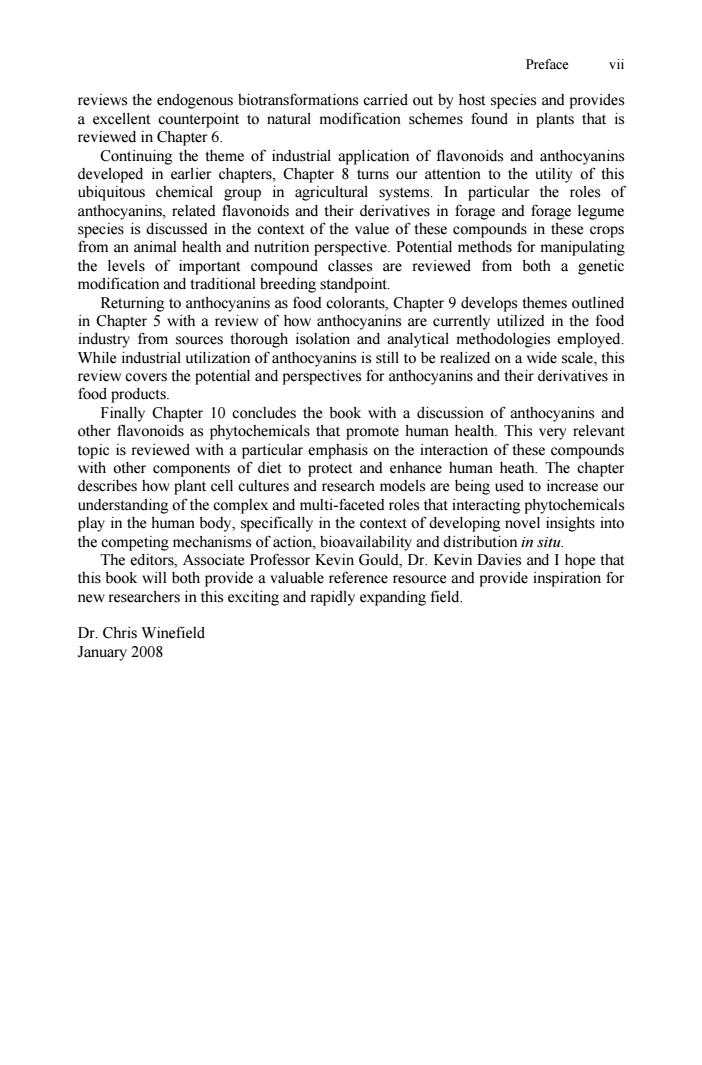
Preface vii reviews the endogenous biotransformations carried out by host species and provides a excellent counterpoint to natural modification schemes found in plants that is reviewed in Chapter 6. Continuing the theme of industrial application of flavonoids and anthocyanins developed in earlier chapters,Chapter 8 turns our attention to the utility of this ubiquitous chemical group in agricultural systems.In particular the roles of anthocyanins,related flavonoids and their derivatives in forage and forage legume species is discussed in the context of the value of these compounds in these crops from an animal health and nutrition perspective.Potential methods for manipulating the levels of important compound classes are reviewed from both a genetic modification and traditional breeding standpoint. Returning to anthocyanins as food colorants.Chapter 9 develops themes outlined in Chapter 5 with a review of how anthocvanins are currently utilized in the food industry from sources thorough isolation and analytical methodologies employed While industrial utilization of anthocvanins is still to be realized on thi potential and food products. mally Chapter 10 concludes the book with a discussion of anthocyanins and other flavonoids as phyto hemicals that note hur ver is reviewed prom cula a pa emp and uman ell cul chap ease ou d rsta mplex mult aceted roles t t interacting phytoche novel insights into the compe ioavailal tion in s ciat Kevin Gould, andIhope th th provide a valuable re erence resource and provide inspiration for new researchers in this exciting and rapidly expanding field. Dr.Chris Winefield January 2008
Preface vii reviews the endogenous biotransformations carried out by host species and provides a excellent counterpoint to natural modification schemes found in plants that is reviewed in Chapter 6. Continuing the theme of industrial application of flavonoids and anthocyanins developed in earlier chapters, Chapter 8 turns our attention to the utility of this ubiquitous chemical group in agricultural systems. In particular the roles of anthocyanins, related flavonoids and their derivatives in forage and forage legume species is discussed in the context of the value of these compounds in these crops from an animal health and nutrition perspective. Potential methods for manipulating the levels of important compound classes are reviewed from both a genetic modification and traditional breeding standpoint. Returning to anthocyanins as food colorants, Chapter 9 develops themes outlined in Chapter 5 with a review of how anthocyanins are currently utilized in the food industry from sources thorough isolation and analytical methodologies employed. While industrial utilization of anthocyanins is still to be realized on a wide scale, this review covers the potential and perspectives for anthocyanins and their derivatives in food products. Finally Chapter 10 concludes the book with a discussion of anthocyanins and other flavonoids as phytochemicals that promote human health. This very relevant topic is reviewed with a particular emphasis on the interaction of these compounds with other components of diet to protect and enhance human heath. The chapter describes how plant cell cultures and research models are being used to increase our understanding of the complex and multi-faceted roles that interacting phytochemicals play in the human body, specifically in the context of developing novel insights into the competing mechanisms of action, bioavailability and distribution in situ. The editors, Associate Professor Kevin Gould, Dr. Kevin Davies and I hope that this book will both provide a valuable reference resource and provide inspiration for new researchers in this exciting and rapidly expanding field. Dr. Chris Winefield January 2008